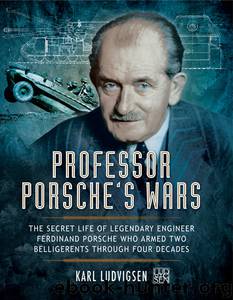Professor Porsche's Wars: The Secret Life of Legendary Engineer Ferdinand Porsche who Armed Two Belligerents Through Four Decades by Karl Ludvigsen

Author:Karl Ludvigsen
Language: eng
Format: epub
Tags: TRANSPORTATION / General
ISBN: 9781473871557
Publisher: Pen and Sword
Published: 2014-08-26T16:00:00+00:00
Under Ferry Porsche’s supervision, Porsche’s designers created a bewildering array of variants based on the Type 60 and 82 designs to meet the war’s exigencies. Dubbed the Type 82E was a high-ground-clearance Kübel chassis carrying a KdF-Wagen body. Two were built in 1941 and from 1942 to 1944 the output was 564 of the Type 82E saloon plus two cabriolets. They were chiefly used by SS units to fly the flag of the Third Reich in occupied lands.
Among the most confusing of Fallersleben’s wartime automobile products – and at the same time among the most interesting – were those with Beetle bodies on four-wheel-drive chassis. Dubbed the Kommandeurwagen or Command Car, this Beetle look-alike had the full 4x4 propulsion equipment under its floorboards. Its dry weight of 1,740lb made it one of the heaviest VW derivatives of the period. Only the much more elaborate Type 166 Schwimmwagen, described in the next chapter, was heavier at 2,005lb empty.
Designed as Porsche’s Type 287, the Command Car seated the ‘commander’ behind the driver with free space to his right, while an adjutant occupied the front passenger seat with a map and writing desk that folded out into position. Rifle racks, a machine-pistol holster and first-aid kits were built in. Floors were wooden-slat-covered for service in the mud of Russia.
Output of this highly specialised Beetle was 134 units in 1942, 382 the following year and 151 in 1944. We can envision them being built by the VW factory to be sold on to the Army on an advantageous basis, a car that looked just like the famous peacetime KdF-Wagen yet was fully equipped to cope with wartime conditions. This was a heady combination that granted exceptional status to any officer fortunate enough to be assigned one of these rare military Beetles.
Ordinary rear-drive Kübels had their own terrain to conquer; twin tyres at the rear of the Type 82 were tried for improved traction. Porsche went even further with half-track-like treads driven from the rear axles in several configurations. Officially the Type 155, this was the Schneeraupe or ‘snow-caterpillar’ to cope with conditions on the Russian front. High cost and complexity stifled its production.
In 1943 another version of the wartime VW, the Type 157, had flanged steel wheels to allow it to be driven on railways. That same year the wartime Beetle’s engine was enlarged from its original 985cc to 1,130cc by expanding its cylinder bore. Horsepower rose only from 23½ to 25 but torque or pulling power was usefully improved.
The larger engine was better suited to the more demanding service imposed by heavier KdF-Wagen variants such as the Type 166. As well it helped compensate for the drop in power that accompanied the use of generator gas as fuel. In Porsche’s Type 230 project VWs were powered by generator gas from a wood-burning plant installed under their distended noses.
Among the many other studies carried out during the war were automatic-transmission experiments; the design of an exhaust-driven turbocharger;* a version of the engine using the
Download
This site does not store any files on its server. We only index and link to content provided by other sites. Please contact the content providers to delete copyright contents if any and email us, we'll remove relevant links or contents immediately.
The Radium Girls by Kate Moore(11863)
100 Deadly Skills by Clint Emerson(4793)
Rise and Kill First by Ronen Bergman(4650)
The Templars by Dan Jones(4592)
The Doomsday Machine by Daniel Ellsberg(4373)
The Rape of Nanking by Iris Chang(4099)
Killing England by Bill O'Reilly(3926)
Hitler in Los Angeles by Steven J. Ross(3865)
Stalin by Stephen Kotkin(3820)
12 Strong by Doug Stanton(3455)
Hitler's Monsters by Eric Kurlander(3240)
Blood and Sand by Alex Von Tunzelmann(3100)
Darkest Hour by Anthony McCarten(3039)
The Code Book by Simon Singh(3020)
The Art of War Visualized by Jessica Hagy(2890)
Hitler's Flying Saucers: A Guide to German Flying Discs of the Second World War by Stevens Henry(2664)
Babylon's Ark by Lawrence Anthony(2486)
The Second World Wars by Victor Davis Hanson(2452)
Tobruk by Peter Fitzsimons(2413)
